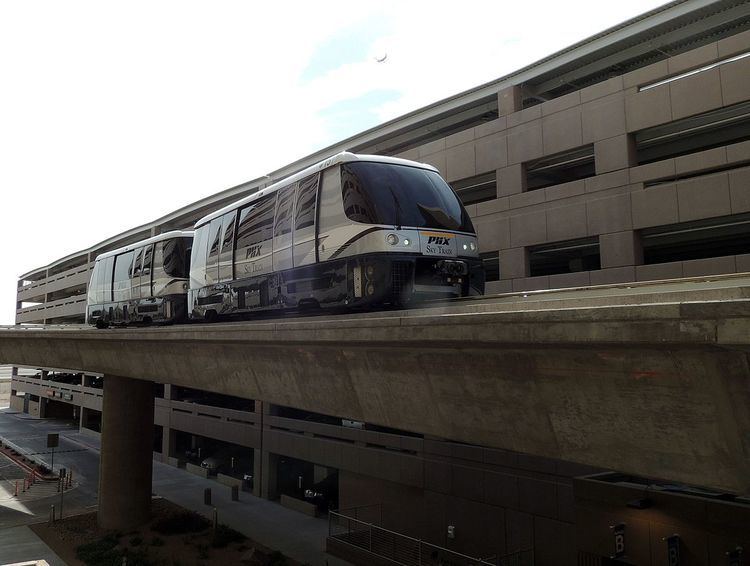 | ||
Innovia APM (stylized as INNOVIA APM) is a rubber-tired automated people mover system (APM) manufactured by Bombardier Transportation. The APM technology was originally developed by Westinghouse, then owned by Adtranz, and most recently acquired by Bombardier in 2001. Since its market debut in 1971, there have been three generations – Innovia APM 100 (known originally as C-100 and CX-100), Innovia APM 200 (originally known as just Innovia people mover) and the latest Innovia APM 300.
Contents
History
Development began in the 1960s when Westinghouse (bought by AEG in 1988, later Adtranz in 1996) first engineered the South Park APM demonstration project in Pittsburgh, Pennsylvania in 1963. The technology came to be known as the Skybus, because it was a rubber-tired vehicle, similar to a bus that operated on a designated elevated roadway. From the very beginning, it was designed to be an automated rapid transit system. Engineers believed that it would be able to move 5,000 to 14,000 per hour per direction, and could offer around-the-clock service every two minutes. The first attempts to bring the Skybus technology to market were controversial, with political leaders holding opposing views on the prospects of a rubber-tired mass transit system. Eventually plans to implement a Skybus system in Pennsylvania were rejected. Despite this, work continued on the technology.
In 1971, the first airport people mover system was opened at Tampa International Airport – beginning a new chapter in transportation history. After Westinghouse was acquired by Adtranz, the technology was marketed as the Adtranz C-100 automated people mover system. The C-100 system (and the newer CX-100 system) was relatively successful in the 1980s and 1990s with 14 new systems delivered. As the competing Mitsubishi Crystal Mover technology grew in popularity, Adtranz began developing a new, more aerodynamic model known as Innovia, which started testing in 1999. In addition to its sleeker appearance, the new Innovia people mover also offered greater speeds, tighter turns, full composite construction and a choice in end caps. The first Innovia people mover system delivered opened in 2005 at Dallas/Fort Worth International Airport. Despite the development of this newer model, Bombardier continued to sell the CX-100 technology under then name Innovia APM 100 while it also marketed the new Innovia people mover technology (last Innovia APM 100 system delivered in 2010). However, after the development of a third generation model and a rebranding strategy by Bombardier to label its entire automated transit system portfolio as ‘INNOVIA’, the two previous models became legacy systems and are no longer marketed to new customers. Although, existing customers can and do still order more vehicles as needed. The third and latest model is called the Innovia APM 300 system. It looks very similar to the original Innovia people mover (now called the Innovia APM 200 system), but is longer, more energy efficient and capable of 6-car train configurations.
In November 2014, Bombardier signed a Joint Venture (JV) agreement with CSR Puzhen in China to develop and manufacture Innovia APM vehicles (as well as Innovia Monorail vehicles) for the Chinese market.
Production
Innovia APM vehicles are assembled in West Mifflin, part of the Greater Pittsburgh Area, Pennsylvania. The multi-building facility specializes in automated people mover technology and has three test tracks.
Implementations
Innovia APM 100 systems at airports:
An Innovia APM 100 system that was installed at Changi Airport in Singapore was replaced in 2006 by a Mitsubishi Crystal Mover.
Urban Innovia APM 100 systems:
Innovia APM 200 systems at airports:
Urban Innovia APM 256 systems:
Innovia APM 300 systems for airports:
Integrated Systems
Innovia APM vehicles operate as part of a fully integrated transit system with all elements (vehicles, signaling, communications, power supply and distribution, trackwork, platform screen doors, etc.) designed to function together as a complete package. Typically, these integrated systems are delivered as a turnkey transit system contract.
Route layout and system configuration
Innovia APM systems are most often used in airport settings as inter-terminal connections or links to local amenities in and around the airport such as car rentals, parking garages and local public transit. Currently there are three urban systems used as feeder systems as part of a larger mass transit network. Innovia APM systems operate in underground tunnels, on elevated guideways, and sometimes in an open cut (pit) or a combination of tunnels and elevated guideways.
They can assume three different system configurations – shuttle, loop, and pinched loop. The shuttle system is the least complex. One train operates on each lane of a dual lane guideway. After the train dwells in one of the end stations for passengers for entry and exit, it reverses direction and returns to the opposite end station. Because Innovia APM vehicles are fully automated, they do not require a driver’s cab, which allows them to be bi-directional. A loop is an enclosed system that connects multiple stations along a track or guideway that is a continuous circle or closed curve. Loop systems can be designed as either a single lane or a dual lane configuration. A pinched-loop system shares common characteristics with both the shuttle and the loop systems. Pinched loops look like a dual-land shuttle (with two parallel guideways), but trains can go from one track to the other changing direction via switches at each end. As a result, traffic on a pinched loop flows in opposite directions on two parallel tracks, but can accommodate many stations.
